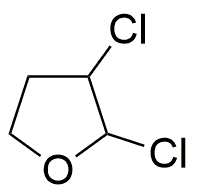2,3-Dichlorotetrahydrofuran is widely utilized in research focused on:
- Synthesis of Fine Chemicals: This compound serves as an important intermediate in the production of various fine chemicals, including pharmaceuticals and agrochemicals, due to its unique reactivity.
- Solvent Applications: It acts as a solvent for organic reactions, providing a stable environment for chemical processes, which is particularly beneficial in laboratories and industrial settings.
- Polymer Production: Used in the synthesis of polymers, it enhances the properties of the resulting materials, making them suitable for applications in coatings and adhesives.
- Research in Environmental Chemistry: Its properties allow researchers to study the degradation pathways of chlorinated compounds, aiding in the development of better environmental remediation strategies.
- Analytical Chemistry: This compound is employed as a standard in various analytical techniques, helping in the accurate quantification of related substances in complex mixtures.
General Information
Properties
Safety and Regulations
Applications
2,3-Dichlorotetrahydrofuran is widely utilized in research focused on:
- Synthesis of Fine Chemicals: This compound serves as an important intermediate in the production of various fine chemicals, including pharmaceuticals and agrochemicals, due to its unique reactivity.
- Solvent Applications: It acts as a solvent for organic reactions, providing a stable environment for chemical processes, which is particularly beneficial in laboratories and industrial settings.
- Polymer Production: Used in the synthesis of polymers, it enhances the properties of the resulting materials, making them suitable for applications in coatings and adhesives.
- Research in Environmental Chemistry: Its properties allow researchers to study the degradation pathways of chlorinated compounds, aiding in the development of better environmental remediation strategies.
- Analytical Chemistry: This compound is employed as a standard in various analytical techniques, helping in the accurate quantification of related substances in complex mixtures.
Documents
Safety Data Sheets (SDS)
The SDS provides comprehensive safety information on handling, storage, and disposal of the product.
Product Specification (PS)
The PS provides a comprehensive breakdown of the product’s properties, including chemical composition, physical state, purity, and storage requirements. It also details acceptable quality ranges and the product's intended applications.
Certificates of Analysis (COA)
Search for Certificates of Analysis (COA) by entering the products Lot Number. Lot and Batch Numbers can be found on a product’s label following the words ‘Lot’ or ‘Batch’.
*Catalog Number
*Lot Number
Certificates Of Origin (COO)
This COO confirms the country where the product was manufactured, and also details the materials and components used in it and whether it is derived from natural, synthetic, or other specific sources. This certificate may be required for customs, trade, and regulatory compliance.
*Catalog Number
*Lot Number
Safety Data Sheets (SDS)
The SDS provides comprehensive safety information on handling, storage, and disposal of the product.
DownloadProduct Specification (PS)
The PS provides a comprehensive breakdown of the product’s properties, including chemical composition, physical state, purity, and storage requirements. It also details acceptable quality ranges and the product's intended applications.
DownloadCertificates of Analysis (COA)
Search for Certificates of Analysis (COA) by entering the products Lot Number. Lot and Batch Numbers can be found on a product’s label following the words ‘Lot’ or ‘Batch’.
*Catalog Number
*Lot Number
Certificates Of Origin (COO)
This COO confirms the country where the product was manufactured, and also details the materials and components used in it and whether it is derived from natural, synthetic, or other specific sources. This certificate may be required for customs, trade, and regulatory compliance.


